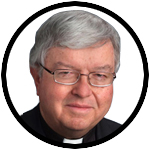
Father Kenneth Doyle
Q. I would like to donate my remains to medical science. Does the Catholic Church approve or disapprove of this action? (Chesapeake, Virginia)
A. The Catholic Church not only allows this but encourages it. Your donation could enable doctors, nurses and medical researchers to understand the human body better and save lives in the future.
The U.S. Catholic bishops in their policy document Ethical and Religious Directives for Catholic Health Care Services state that Catholic health care facilities should provide the means for those who wish to donate organs and bodily tissue both for transplant and for research (No. 63). Likewise, St. John Paul II in his 1995 encyclical “The Gospel of Life” called organ donation an act of “everyday heroism” that nurtures a genuine culture of life (No. 86).
[hotblock]
A couple of cautions are in place, though. First, a Catholic funeral Mass may and should still be held, even without the presence of the body (i.e., a memorial Mass), to entrust the deceased person to the Lord and to allow the family to mourn and pray together.
Next, following the medical research, any bodily remains should be entombed or buried in consecrated ground. And finally, it is wise for someone intending to donate his or her body to communicate that desire to family members well in advance to avoid surprise or family friction at the time of death.
Q. Our parish is meeting in temporary quarters for Mass because we are building a new church. This place has the American flag and the Arkansas state flag flanking the altar. Should those flags be removed during the Mass? (Jonesboro, Arkansas)
A. Perhaps surprisingly, the Catholic Church has no binding regulation on the placement of flags within a church building — neither in the Code of Canon Law nor in any of its liturgical books. It is left to the judgment of the diocesan bishop, who most often leaves it to the discretion of the local pastor.
Having said that, it is true that the U.S. bishops’ Committee on the Liturgy has encouraged Catholic parishes not to place a national flag in the sanctuary itself and so, more often, it is displayed in a church’s vestibule. Underlying that suggestion is the fact that Catholics belong to a universal faith community that transcends national borders and that, as St. Paul tells the Philippians (3:20), our primary citizenship is in heaven.
This same thinking guides the placement of flags on a casket during a funeral Mass, and here there actually is a rule that governs. The Order of Christian Funerals provides that “any national flags or the flags or insignia of associations to which the deceased belonged are to be removed from the coffin at the entrance of the church. They may be replaced after the coffin has been taken from the church” (No. 132). During the Mass itself, a white funeral pall normally covers the casket as a symbol of the person’s baptism.
It sounds to me from your question, though, that you may be borrowing a Protestant worship space while your own new church is being built. If this is the case, I think that as a grateful guest I would be cautious about doing any “structural rearrangement” and might be tempted to leave the national and state flags just where they are.
***
Questions may be sent to Father Kenneth Doyle at askfatherdoyle@gmail.com and 30 Columbia Circle Dr., Albany, New York 12203.
PREVIOUS: Come, Holy Spirit!: Black spirituality and the Catholic Church
NEXT: Valuing cultural diversity in parishes



Share this story